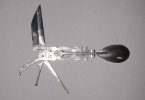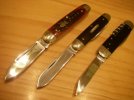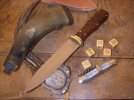I can't recall if I ever put this question to the porch before, just one of the penalties for reaching an age where I'm having trouble remembering what Ihad for breakfast. But
Looking all over the world, a good deal of it I had the good fortune to have traveled to while serving in the army, it seems the working guys knife, the knife in the hands of the guy opening a bag of cement, cutting off some twine to go between the survey stakes, stripping some insulation off a wire to make a connection, or just eating lunch, is a single blade pattern. The Opinel and Douk-Douk from France, the F. Herders and Mercators from Germany, the navaja and terramundi from Spain, The Zuava from Italy, and the Resolza from Sardinia, as well as the pruning knives and real Lambs food jacks from England, all are single blades for the most part. The Higonokami from Japan, is yet another example of the working mans pocket knife. And lets not forget the Okapi from South Africa.
With the exception of the U.S. and England, it seems like we are the sole market for the multi bladed pocket knives. The famed Swiss Army Knives seem to be a international exception, but those are multitool knives with the extra "blades" being functional tools like screw drivers and corkscrews. There are lots of beautiful examples of lobster patterns from Sheffield's heyday, with little scissors, nail files, pipe reamers, and ever a knife blade or two, encased in exquisite pearl handles. But these seem to be the exception to the rule, and the fact that these knives survived seem to point to them being in the hands of the landed gentry, who have no real hand labor to do.
Would a vinyard worker or farm hand in France ever use a stockman, or a forester in the forests of Germany be using a Barlow? Or a construction guy in Italy use a congress?
Yes, I know that Sheffield and Solingen produced these patterns in huge numbers, but how much of them were for the rich export markets in American? Inquiring minds want to know. Or at least mine does.
Edit to add; I remember walking around in different market places in different places like in Tripoli Libya, or Vietnam, and never seeing a single American style traditional pocket knife. Yet, in Tripoli they had baskets full of Douk-Douk's and Opinels. In Vietnam they had tons of Japanese low cost folders with single blades. And in France of course, were boxes of Opinel's and displays of lots of other French cutlery, almost all single blades.
Looking all over the world, a good deal of it I had the good fortune to have traveled to while serving in the army, it seems the working guys knife, the knife in the hands of the guy opening a bag of cement, cutting off some twine to go between the survey stakes, stripping some insulation off a wire to make a connection, or just eating lunch, is a single blade pattern. The Opinel and Douk-Douk from France, the F. Herders and Mercators from Germany, the navaja and terramundi from Spain, The Zuava from Italy, and the Resolza from Sardinia, as well as the pruning knives and real Lambs food jacks from England, all are single blades for the most part. The Higonokami from Japan, is yet another example of the working mans pocket knife. And lets not forget the Okapi from South Africa.
With the exception of the U.S. and England, it seems like we are the sole market for the multi bladed pocket knives. The famed Swiss Army Knives seem to be a international exception, but those are multitool knives with the extra "blades" being functional tools like screw drivers and corkscrews. There are lots of beautiful examples of lobster patterns from Sheffield's heyday, with little scissors, nail files, pipe reamers, and ever a knife blade or two, encased in exquisite pearl handles. But these seem to be the exception to the rule, and the fact that these knives survived seem to point to them being in the hands of the landed gentry, who have no real hand labor to do.
Would a vinyard worker or farm hand in France ever use a stockman, or a forester in the forests of Germany be using a Barlow? Or a construction guy in Italy use a congress?
Yes, I know that Sheffield and Solingen produced these patterns in huge numbers, but how much of them were for the rich export markets in American? Inquiring minds want to know. Or at least mine does.
Edit to add; I remember walking around in different market places in different places like in Tripoli Libya, or Vietnam, and never seeing a single American style traditional pocket knife. Yet, in Tripoli they had baskets full of Douk-Douk's and Opinels. In Vietnam they had tons of Japanese low cost folders with single blades. And in France of course, were boxes of Opinel's and displays of lots of other French cutlery, almost all single blades.
Last edited:













